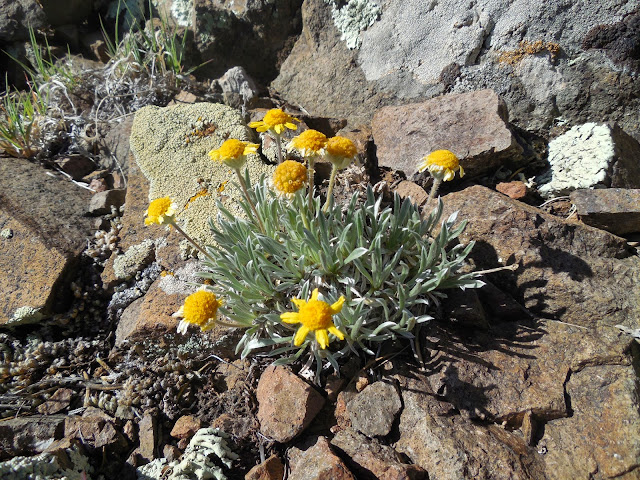 |
| Claret cup on the San Luis Hills |
 |
| Another claret cup |
 |
| And yet another |
 |
| And another! |
 |
| Fallugia paradoxa |
 |
| Tetraneuris (Hymenoxys) acaulis |
Just a few days past peak, the clumps were still enchanting. This form seems to be grading into what has been called var. caespitosa--the nearly stemless alpine form common above treeline. But you find something comparable all over the Wyoming Red Desert and steppe, and here and there around Colorado as well. The common lowland form can have stems six or even ten inches tall.
Isn't this a handsome clump? This has always been one of my favorite native daisies (and we have more than our share)--I have some clumps that have persisted in my home rock garden for at least a decade--nearly two.
 |
| Monarda pectinata |
Back to a few more shots of cacti--here some very spiny Opuntia in with the claret cups.
 |
| Opuntia polyacantha |
We were a few days away from bloom time on the prickly pears--it looked as though they were all yellow flowered. As I look at these stems, I realize they approach hystricina in spiny-ness. I wish now I'd brought back a cutting to compare with one of the many dozens of polyacantha I already grow: So little time, so many cactus pads!
Here's Mike Bone, a wonderful field worker (and good friend)--who always seems to make it to some picturesque spot--there were some cool plants there!
As we departed the hills we noticed some enormous stands of yucca in the distance. Of course, we had to check them out: this seems to just be a rather dwarf form of Yucca glauca--with lovely short racemes of flowers: it would be fun to grow this alongside our local form to compare. Alas, no seed in sight.
A typical and charming colony--very uniform. I suspect they're all one clone that's spread rhizomatously over decades (or longer)...here blooming in mid June--at over 8000'--long after ours were done in the Gardens.
Mike posing near an especially short flowered colony: perhaps one day we'll venture back near here when the seed is ripe (and we have our permits to collect of course!): although I don't believe there's a rancher in the state who wouldn't welcome us taking the whole lot.












Excellent. I collected O. polyacantha seed just NW of there near Mt. Blanca and the youngsters are coming up. The plants look similar - with the yellow flowers as you mentioned. I could have sworn we saw very low growing E. viridiflorus there near Mt. Blanca - which would be ideal for me to try. When we returned the second time, couldn't find 'em. So no seed.
ReplyDeleteI did find tiny Yucca glauca like that, both in that Mt. Blanca area and in Park County west of Spinney Mountain Reservoir. I got seed and some have even been sent to Europe - I still haven't sown them. What have I been waiting for??
I have unfortunately never been to Colorado in midsummer, to collect seed from perennials like the Hymenoxis ;) and the countless other fantastic plants. Every seed I have collected has been a throwback to last year!
Great shots - I live for those days too.
EAST of Spinney. And Hymenoxys... ;)
ReplyDelete